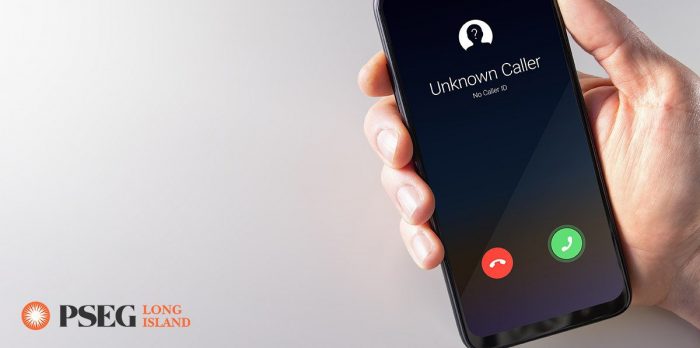Summer of Scam: PSEG Long Island urges customers to learn the telltale signs
Customers should think twice if someone calls and threatens to immediately shut off their power
Just like the summer itself, scammers are turning up the heat, pretending to be PSEG Long Island or impersonating prominent area utilities, and threatening to turn off service for nonpayment. PSEG Long Island urges customers to understand scammers’ tactics and do the right thing if confronted with a demand for payment: Get the truth from the real PSEG Long Island at 1-800-490-0025.
“Scammers do their best to create the impression of an urgent problem in the hopes that your panic will prevent you from seeing all the clues that they’re not who they appear to be,” said Rick Walden, PSEG Long Island’s vice president of Customer Services. “PSEG Long Island wants customers to know the signs, take a moment to think, and then contact us directly using the number on their bill if they’re still not sure.”
More than 1,400 scam calls have been reported to PSEG Long Island so far in 2022. Many of these scammers are demanding immediate payment via web-based electronic payment services. PSEG Long Island does not accept web-based electronic payment services as a method of payment.
What customers should know about payment scams
- Scammers impersonating PSEG Long Island most frequently threaten to shut off power immediately unless payment is made.
- Many scammers use phone “spoofing” technology to make their number display on your phone as “PSEG Long Island.”
- PSEG Long Island will never request that customers use one specific method of payment.
- Scammers typically want their victims to transfer money via a web-based electronic payment service, a prepaid debit card, or even Bitcoin, sometimes asking people to buy a prepaid card at the nearest convenience store and then to read them the PIN over the phone.
- PSEG Long Island does not accept web-based electronic payment services, prepaid debit cards or Bitcoin as payment.
- Sometimes phone scammers will demand a deposit for a priority meter installation. PSEG Long Island does not require a deposit for meter installations.
- If a customer has doubts about the legitimacy of a call or an email — especially one in which payment is requested — they should call the company directly at 1-800-490-0025.
What customers should know about shutoffs
- On July 12, after more than two years of suspending service shutoffs due to a pandemic-related state of emergency, PSEG Long Island resumed service shutoffs for accounts that do not respond to repeated efforts to establish a payment agreement.
- Shutoff of service for nonpayment is a last resort that only occurs after PSEG Long Island makes multiple efforts to contact and help the customer.
- Customers with unpaid balances who do not already have a deferred payment agreement should call 1-800-490-0025 so PSEG Long Island can assist them.
- If previous outreach efforts are unsuccessful, a PSEG Long Island representative will make a final attempt to contact the customer of record, in person, to accept a payment and avoid a shutoff.
- When service is terminated, a service suspension notice will be left at the location with instructions on how to work with PSEG Long Island to reconnect.
In-person visits
Occasionally, scammers may go door to door impersonating PSEG Long Island employees, flashing a fake ID and/or claiming to be a utility collection representative. The impostors may wear “uniforms” or affix false company signs to their vehicles. The scammers generally ask for personal information, which real utility representatives do not do, or offer bogus discounts. Again, if customers have any doubts, they should not let the person in, and should call 1-800-490-0025 to verify.
PSEG Long Island employees must carry a company ID and present it when requested. If customers have doubts, do not let the person into the house and call 1-800-490-0025 to have a customer service representative verify that an employee has been dispatched to the location. An actual PSEG Long Island employee will respect the customer’s decision and remain outside. If the person escalates their efforts to enter the home, customers should consider calling 911.
Fake websites
Some scammers purchase web domains that closely resemble the actual URL of a utility and create a fraudulent replica of the legitimate website. Their plan is to dupe users who click on these fake sites via search results, or type in an inaccurate web address. Once on the spoofed site, a visitor is presented a number of bill payment options, all pointing back to an outside bill pay site.
PSEG Long Island always uses the “.com” domain. Its real website can be found at www.psegliny.com.
How actual PSEG Long Island reps handle phone calls
Customers should also know what PSEG Long Island will and won’t discuss over the phone. A genuine PSEG Long Island representative will ask to speak to the Customer of Record. If that person is available, the representative will explain why they are calling and provide the account name, address and current balance. If the person on the phone does not provide the correct information, it is likely the customer is not speaking with a PSEG Long Island representative.
If the Customer of Record is not available, the PSEG Long Island representative will not discuss the account at all and ask that a message be left for the Customer of Record to call 1-800-490-0025.
PSEG Long Island is a member of the Utilities United Against Scams (UUAS) collaborative. UUAS, a consortium of more than 145 U.S. and Canadian electric, water, and natural gas utilities and their respective trade associations, has helped to create awareness of common and new scam tactics and to cease operations of nearly 5,000 toll-free numbers used against utility customers by scammers.
For more information on various payment scams reported in the PSEG Long Island service area and around the country, visit https://www.psegliny.com/myaccount/customersupport/scamsandfraud.







